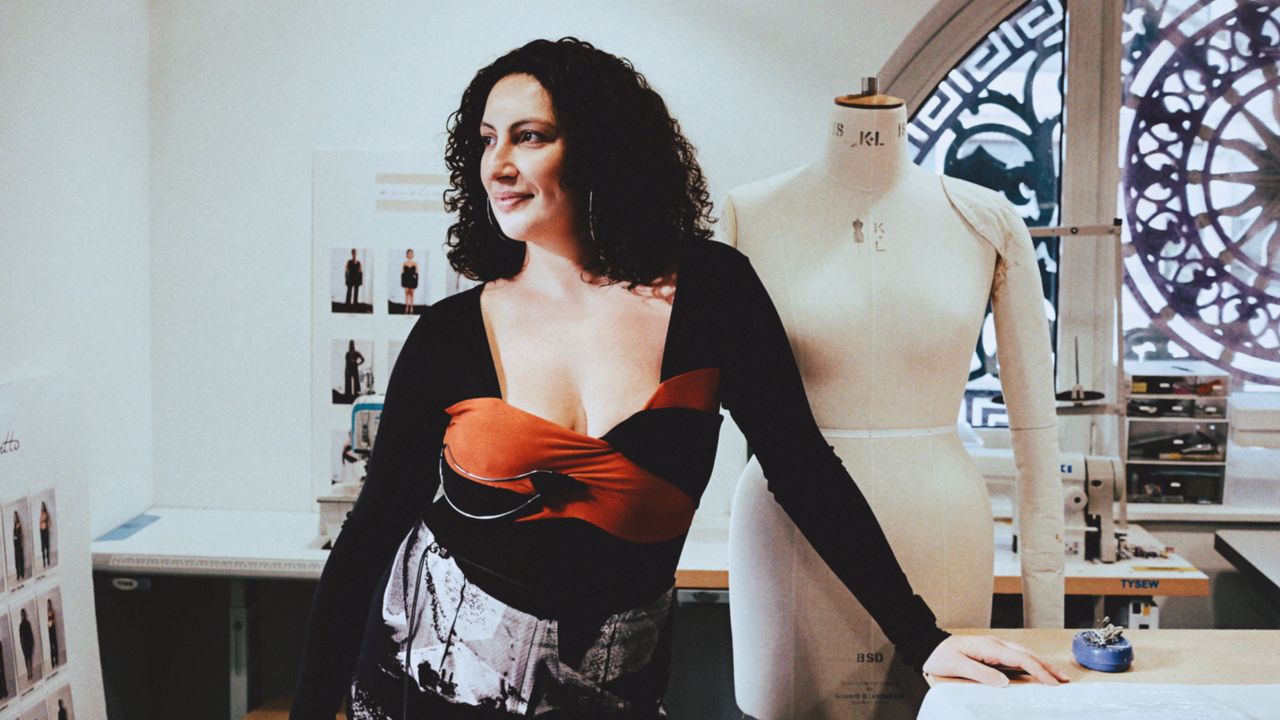Karoline Vitto’s designs are all about contouring curves rather than concealing them – proving every body belongs in high fashion.
Raised in Caçador, Brazil, fashion was always a constant in Vitto’s life — her grandfather was a cobbler, and her grandmother a seamstress. It was precisely her family’s craftsmanship that led her to London, where she decided to hone her design skills at Central Saint Martins and the Royal College of Art.
Growing up in Brazil, Vitto was surrounded by a strong swim culture predominantly focused on and exporting mostly “beach-ready” bodies. “I feel the whole body positivity movement has had a huge impact on how people perceive themselves and also how brands show their work,” Vitto tells Teen Vogue from inside her studio in Farringdon’s iconic Smithfield Market, a staple for the city’s culture, on a sunny Thursday afternoon in the middle of London Fashion Week.
Photo by Sara Delgado
The lack of size diversity in high fashion inspired Vitto to start her namesake brand in 2020, creating a safe space committed to celebrating and embracing the female form’s natural curves and folds without room for tokenization.
Today, her collections feature signature, sophisticated jersey dresses, and sculptural hardware – functioning as adjustable and fashionable features. Vitto’s choice of flexible and conscious materials, as well as her women-led design processes, elevate the brand’s mission beyond a mere ethos, transforming it into its own movement.
Starting off at talent incubator Fashion East, Vitto’s unmistakable designs and approach have since gained her a spot in the British Fashion Council’s (BFC) NewGen initiative alongside Chet Lo, Di Petsa, Tolu Coker, and Aaron Esh. The program is designed to support emerging designers with financial assistance, showcasing opportunities, and mentorship. In 2024, Vitto reached another milestone, becoming the first Brazilian female designer to be a semi-finalist for the LVMH Prize.
As she collects firsts, Vitto continues to grow her knowledge with her brand – crafting with inclusion, community, and sustainability in mind. Greeting us in her studio and surrounded by her creations, Teen Vogue sat down with the designer to talk about the influence of Brazil in her work, gradual upscaling, and what the future holds.
Teen Vogue: What can you tell us about growing up in Brazil and how the conversations around the body have evolved and inspired your work?
Karoline Vitto: They definitely have evolved. There was a lot of swimwear culture in Brazil in the ‘90s. Back then, fashion was about two big fashion weeks: São Paulo Fashion Week and Rio Fashion Week. Rio Fashion Week doesn’t exist anymore, but at the time, it was a very strong fashion week for beachwear. I remember that being the conversation around bodies and being “beach body” ready. Also around that time, in terms of fashion, one of the biggest exports of Brazil was the models – Gisele Bündchen, etc. There wasn’t a lot of diversity, but the Brazilian models, actresses, and everyone we just saw in the media weren’t real reflections of what we saw when we went outside to the beach. There was this idea of this Brazilian body, but it felt really fabricated. Over the last 10 years, it’s been changing, and I feel the whole body positivity movement has had a huge impact on how people perceive themselves and also how brands show their work. I feel like representation has really been evolving in Brazil, and I personally think it’s been a good progression.
TV: Do you find that you reference Brazil in different ways in your designs?
KV: Yeah, definitely. I think there’s always a degree of trying to be close to home when I design. That’s why I like to go back to Brazil periodically to find inspiration, talk to people, or see clothes. I definitely have a need to be in that environment in order to feed myself creatively. Then I bring it here, and I make it a bit more London. And I try to adapt to the way that I live here. Now, I think I’m in a moment where I’m really trying to find where the Brazilian me and the London me meet.


